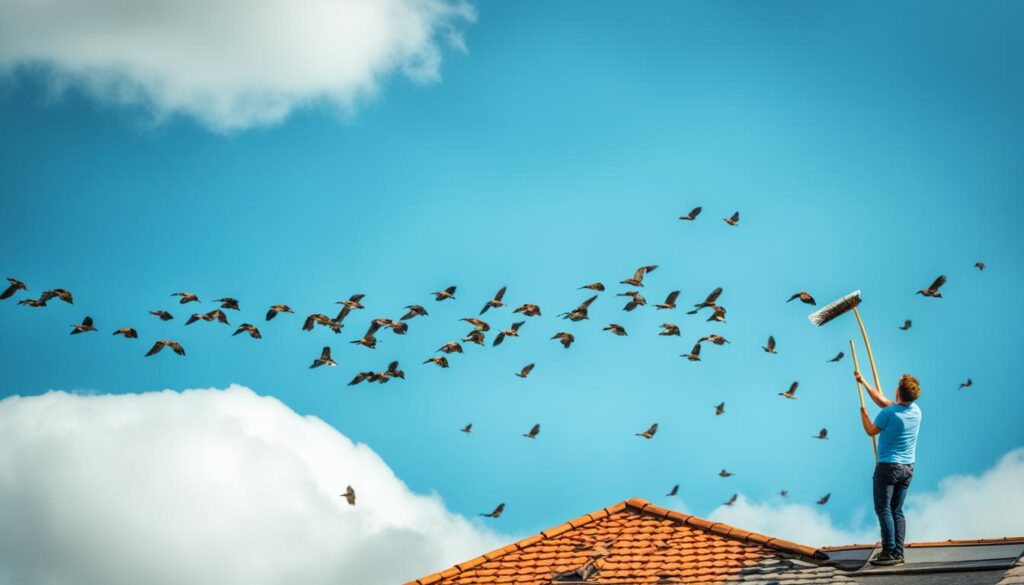A flock of pigeons sat on a rooftop, making Sarah worried. She saw them as a health risk. She wondered, “How can I keep these birds off my roof?”
Birds have learned to live in cities, often near our homes. A few birds might seem okay, but they can become a big issue. Their droppings are harmful, damage roofs, and draw more pests. It’s important to keep birds off your roof for your health and home safety. We’ll look at ways to keep birds away without hurting them.
Key Takeaways
- Birds on the roof can pose health risks and cause property damage
- Effective bird deterrents include blocking food/water sources, using scare tactics, and installing physical barriers
- Professional pest control companies can help assess the situation and recommend the best bird-proofing solutions
- It’s important to follow local laws and regulations when dealing with birds nesting on the roof
- Maintaining the roof and addressing any potential attractants can help prevent birds from returning
Why Birds on the Roof are a Problem
Birds on your roof can be a big health risk. Their droppings carry over 60 diseases that can spread to humans. These include serious infections like Cryptococcosis, Psittacosis, and Histoplasmosis. Just breathing in dust from these droppings can make you sick.
Bird nests also bring parasites like bed bugs, ticks, and lice. They can also attract rodents and snakes. The droppings are acidic and can harm your roof’s materials. They can also block gutters and vents, which is bad for your home’s structure.
Health Risks from Bird Droppings and Nests
- Over 60 zoonotic diseases can be spread through bird droppings, including Cryptococcosis, Psittacosis, and Histoplasmosis
- Parasites like bed bugs, ticks, and lice can infest nests and spread to your home
- The acidic nature of bird droppings can damage roofing materials and block gutters and vents
- Rodents and other pests can be drawn to bird nests on your roof
“Research shows that 88% of businesses report a decrease in customer satisfaction due to the presence of pest birds on their roofs.”
It’s important to deal with bird problems on your roof. This keeps your family safe and your home in good shape. Taking action early can prevent bigger problems later.
Types of Damage Caused by Birds on Roofs
Birds on your roof can cause serious problems. They can damage your property in many ways. From corrosive droppings to blocked gutters and vents, birds can lead to costly issues.
Bird droppings are highly acidic and can harm your roof. They can shorten the life of your roof. In fact, a small amount of droppings can cut a warehouse roof’s life in half.
Birds also block gutters and vents with their nests. This can stop water and air flow, causing water damage and motor wear. It can even be a fire risk if the nests are made of flammable materials.
- Bird droppings can fade and damage car paint finishes
- Acidic droppings can harm air conditioning equipment, machinery, siding, and insulation
- A gas station canopy collapsed in Arizona in 2008 due to pigeon droppings
- Many warehouses suffer roof damage or collapse each year from bird nests blocking drainage
The damage from birds can also make people think your building is not well-maintained. It’s important to remove bird nests quickly and keep your roof and gutters clean. This helps protect your property from these risks.
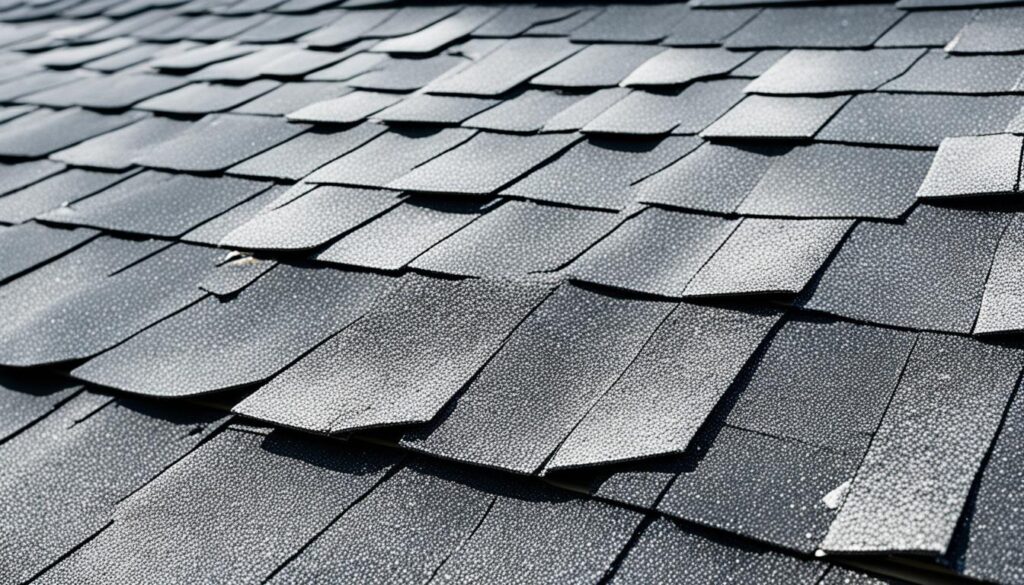
“Pest birds cause tens of millions of dollars of damage to American buildings, roofs, and machinery every year.”
What Attracts Birds to Roofs
Birds are drawn to roofs for many reasons. Food in the area is a big draw. Things like trash cans, pet food, and insects can attract them.
As natural homes disappear, birds look for new places to live. Roofs seem like a good option because they’re high up and safe from predators.
Also, features like balconies, chimneys, and skylights make great spots for birds. They offer a place to watch, hide, and stay safe from the weather.
“Birds are attracted to roofs because they provide observation spots, shelter, and protection from elements and predators.”
Knowing why birds come to your roof helps you deal with the issue. It can prevent damage or health risks from their presence.
Identifying Bird Nests on Your Roof
First, check if birds have made your roof their home. Look for signs of nesting birds early to prevent damage and health risks. Watch for these signs:
- Increased bird activity and gatherings at regular times, which could suggest a nearby nesting site
- Presence of nest materials like sticks, twigs, or paper debris
- Concentrated droppings in certain areas
- An abundance of feathers
- Audible chirps or sounds of birds building their nests
Pigeons, starlings, sparrows, and mynas are common roof nesters. Spotting these signs of birds nesting on roof helps you act fast. This way, you can identify bird nests early.
“Early detection of bird nesting activity is key to preventing damage and health risks associated with birds on the roof.”
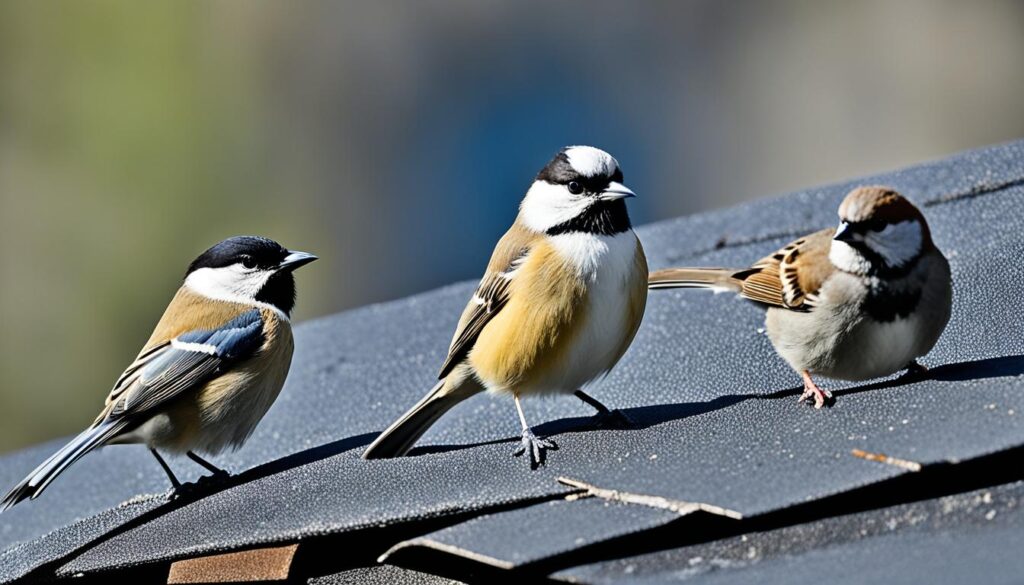
By identifying bird nests and spotting signs of nesting birds, you can stop them from staying. Being quick to act saves you from expensive repairs and health risks later.
How to Get Rid of Birds on Roof?
To keep birds off your roof, start by removing what draws them there. This means cutting off their food and water sources. Make sure trash cans and compost bins are sealed well. Also, clean up any spilled pet food and trim back trees and bushes that have fruit.
Don’t forget to clear out gutters and other places with standing water. This helps get rid of places where birds can drink. By doing these things, you make your area less inviting for birds. This encourages them to find a new place to live.
Remove Food and Water Sources
- Secure trash cans and compost bins to prevent access to food waste.
- Clean up any spilled pet food in the yard or around the home.
- Trim back fruit-bearing trees and bushes that may attract birds.
- Clear out gutters and standing water to eliminate drinking sources.
By eliminating food and water sources, you make your roof less appealing to birds. This is a key step in getting rid of birds on your roof.
“Removing the resources that attract birds is one of the most effective ways to get them to leave your roof for good.”
Using Deterrents to Scare Birds Away
To keep birds off your roof, removing food and water might not be enough. You’ll need to use visual and sonic deterrents to scare them away.
Predator decoys like fake owls, hawks, or snakes can make birds think a threat is there. This makes them avoid your property. Reflective objects, such as shiny things, mirrors, and windsocks, can also confuse and scare birds away.
Sonic deterrents that play sounds of predators or distressed birds work well too. These sounds can make birds leave. Remember to change these deterrents often, as birds can get used to them quickly.
- Place fake predator decoys like owls, hawks, or snakes to scare birds away
- Use reflective objects like shiny objects, mirrors, and windsocks to confuse birds
- Utilize sonic deterrents that play recorded predator calls or bird distress sounds
- Rotate and change up deterrents regularly to keep birds from getting used to them
Using bird deterrents for roofs, predator decoys, reflective objects, and visual and sonic deterrents together can keep birds from nesting on your roof. This helps reduce damage and health risks they might cause.
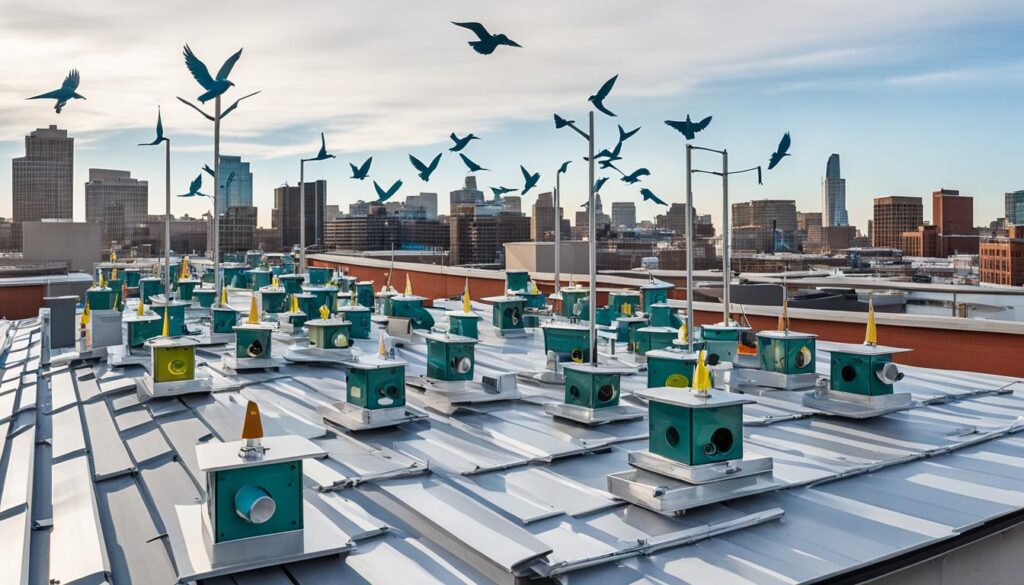
Exclusion Methods to Block Birds
When deterrents don’t work, you might need to block birds from getting to your roof. Bird netting is a top choice, acting as a barrier that stops birds from landing or making nests. Netting with 3/4-inch mesh is strong enough to keep big birds away.
Bird spikes on ledges and beams make it hard for birds to roost. Angled roof surfaces, like Bird Slope products, remove flat spots birds like to nest in. These bird exclusion methods take more work upfront but keep birds away for a long time.
Netting, Spikes, and Slope Products
- Bird netting stops birds from landing or nesting by acting as a barrier.
- Bird spikes make it hard for birds to roost on ledges and beams.
- Angled roof surfaces get rid of flat spots birds like for nesting.
These bird exclusion methods might cost more at first, but they protect your roof from birds for a long time.
Protecting Birds During Nesting Season
When dealing with birds on your roof, it’s key to follow laws that protect their nests and eggs. The Migratory Bird Treaty Act and similar laws don’t let you move or disturb active bird nests, even on your property. Trying to move or destroy a nest can lead to legal trouble.
If you find a nest on your roof, it’s best to call a professional wildlife control service. They can check the situation and decide the right, legal steps to take. This ensures any nest removal is done safely and follows local rules. Working with professionals for nest removal is the safest and most responsible choice.
“All bird species and their nests are legally protected by law. Populations of many wild birds are declining, emphasizing the importance of providing nesting refuges where possible.”
Laws protecting birds nests help keep these important animals safe. Even if birds nesting on your roof is a problem, it’s key to respect their right to a safe place. By working with experts, you can solve your issues while protecting the birds.
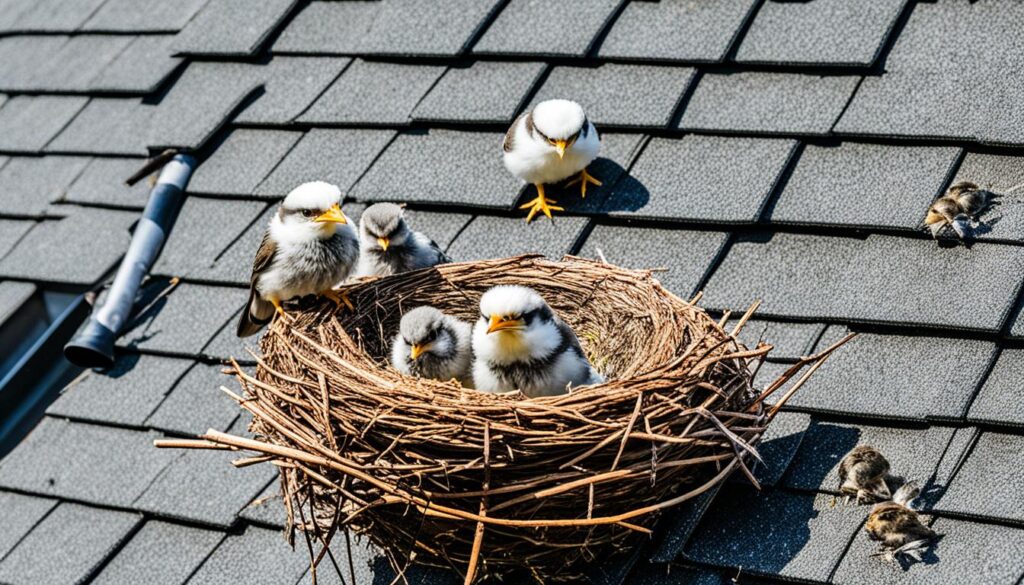
In some cases, giving birds alternative places to nest, like birdhouses or nest boxes, can be a good idea. This helps save bird populations and can also stop damage to your roof. Being patient and working together can help humans and birds live together peacefully.
Maintaining Your Roof to Deter Birds
Keeping your roof in top shape is key to keeping birds away. Fixing common roof problems makes your property less welcoming to birds. Let’s look at the main steps to keep birds off your roof.
Repair Holes, Level Surfaces, Secure Gravel
First, check your roof for gaps, holes, or cracks that birds might use to get in. Fix these right away to stop them from nesting. Also, make sure your roof is even, without any low spots that could hold water.
For roofs with gravel, keep the gravel in place well. Birds might use loose gravel for nests or as grit. A smooth, even, and secure roof makes your property less attractive to birds.
“Proper roof maintenance is key to deterring birds from making your home their own. By addressing common issues like holes, uneven surfaces, and loose gravel, you can create an environment that’s less appealing to our feathered friends.”
Regular roof care helps prevent bird problems like health risks and damage to your property. By keeping up with roof maintenance, you can keep birds away and protect your home.
Sonic and Visual Deterrents
To keep birds off your roof, using both sound and light can work well. Sound and light deterrents like devices that play bird distress calls or look like predator decoys can scare birds away. They make birds think there’s a real threat, so they leave.
Bird Chase Units are a great choice. They make sounds that warn birds to leave. These solar-powered units can protect up to 1 acre and work day or night. You can add more speakers to make a bigger area safe.
Reflective objects like kites that look like birds of prey can also scare birds off. These are easy to put up and don’t cost much. But, birds might get used to them over time. So, you should change them often to keep them working well.
“The bird distress and predator calls are repeated every 10 minutes, and the device can be programmed to turn on or off at night, ensuring continuous protection.”
Using sound and light deterrents together can really help keep birds off your roof. This way, you can stop damage or health risks. Just remember to change your deterrents often, as birds can get used to them quickly.
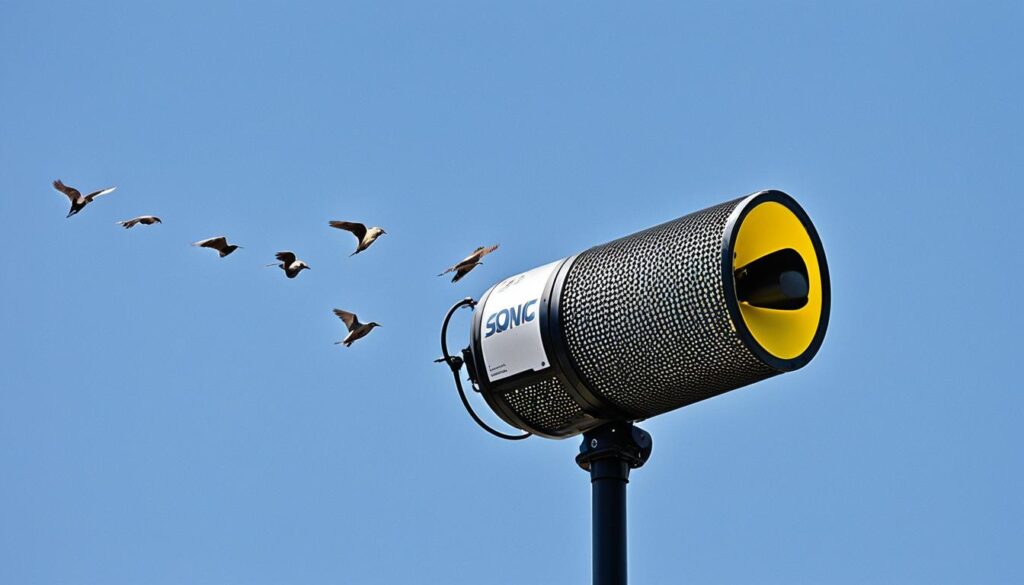
How to Get Rid of Birds on Roof?
Dealing with birds on your roof can be tough, but you can take steps to get them to leave. First, remove any food and water sources that might be drawing them. This will help stop them from coming back.
Then, try using deterrents to scare them away. Things like life-like owl or hawk statues can make birds think there’s a predator around. Shiny streamers or holographic tape can also startle them. And, sonic devices that make high-frequency sounds they don’t like can be another option.
- Eliminate food and water sources that may be attracting birds
- Use predator decoys and reflective objects to scare birds away
- Implement sonic devices that emit high-frequency sounds unpleasant to birds
For a long-term fix, think about using physical barriers. Bird netting, spikes, or angled roof surfaces can keep birds from getting on your roof. These physical barriers are great at stopping birds from nesting and roosting.
Some bird species and their nests are protected by law. So, it’s key to talk to professional wildlife control experts to make sure you’re handling the situation right. With the right mix of prevention, deterrents, and barriers, you can keep your roof bird-free and safe.
Conclusion
Dealing with birds on your roof can be tough, but you can win the battle with the right strategies. Use a mix of deterrents, exclusion methods, and roof upkeep to keep them away. Always be on your toes, as birds can easily find new ways to nest.
Keep changing your deterrents and fix any roof issues that might draw birds. This way, you can keep your roof bird-free.
With the right steps, you can protect your home and family from bird-related issues. This article has shown you how to remove food and water, install barriers, and use deterrents. Put these tips together for a solid plan to keep birds off your roof.
Being proactive is key, as birds are clever and won’t give up easily. Keep an eye out and use different methods to take back your roof. This will help protect your home from bird damage and problems.
FAQ
What are the health risks of having birds on the roof?
Bird droppings can carry over 60 diseases that can spread to humans. These include serious infections like Cryptococcosis, Psittacosis, and Histoplasmosis. Birds also bring pests like bed bugs, ticks, and lice, and can attract rodents and snakes.
What types of damage can birds cause to a roof?
Bird droppings can damage roofing materials like asphalt shingles. Nests in gutters can block them, causing water to build up and potentially lead to leaks. Nests in chimneys can also block airflow, trapping smoke and carbon monoxide inside.
Bird nests made with flammable materials are a fire risk.
What attracts birds to nest on roofs?
Birds are drawn to roofs because of the food available, the lack of natural habitats, and the protection from predators. Roofs offer a safe place for them to raise their young.
How can I identify if birds are nesting on my roof?
Look for large groups of birds at the same time, nest debris, lots of feathers, and the sounds of birds building nests or chicks chirping.
What are some effective ways to get rid of birds on my roof?
You can remove food and water sources, use deterrents like predator decoys and sonic devices, and try physical exclusion methods like bird netting, spikes, and angled roof surfaces.
Can I remove bird nests myself?
No, in many places, it’s illegal to remove or disturb bird nests. It’s best to call a professional wildlife control service to check the situation and find a legal way to handle it.
How can I maintain my roof to discourage birds?
Fix any holes or gaps, make sure the roof is level, and secure gravel on gravel-topped roofs. This makes your roof less inviting for birds to nest.
